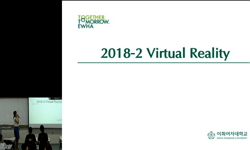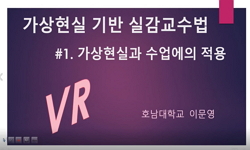본 연구는 미디어 어트랙션으로서 최근에 가장 주목받고 있는 HMD 기반 가상현실의 지속적인 성장을 위한 콘텐츠 디자인 방법론을 찾기 위한 목적으로 시행되었다. 현재의 가상현실 콘텐츠...
http://chineseinput.net/에서 pinyin(병음)방식으로 중국어를 변환할 수 있습니다.
변환된 중국어를 복사하여 사용하시면 됩니다.
- 中文 을 입력하시려면 zhongwen을 입력하시고 space를누르시면됩니다.
- 北京 을 입력하시려면 beijing을 입력하시고 space를 누르시면 됩니다.
https://www.riss.kr/link?id=A101955737
- 저자
- 발행기관
- 학술지명
- 권호사항
-
발행연도
2016
-
작성언어
Korean
- 주제어
-
등재정보
KCI등재
-
자료형태
학술저널
-
수록면
91-106(16쪽)
-
KCI 피인용횟수
12
- DOI식별코드
- 제공처
-
0
상세조회 -
0
다운로드
부가정보
국문 초록 (Abstract)
본 연구는 미디어 어트랙션으로서 최근에 가장 주목받고 있는 HMD 기반 가상현실의 지속적인 성장을 위한 콘텐츠 디자인 방법론을 찾기 위한 목적으로 시행되었다. 현재의 가상현실 콘텐츠들은 대부분 지각적 몰입의 설계에만 집중함으로써 가상현실이 궁극적으로 추구하는 감각의 융합에 도달하지 못하는 한계점을 가지고 있다. 이러한 한계를 극복하기 위해서는 가상현실 콘텐츠에 심리적 몰입 요소를 적용하는 노력이 요구된다. 가상현실 콘텐츠에서 심리적 몰입 요소 적용하는 방법을 찾기 위해 ‘가상성(Virtuality)’을 중심으로 가상현실의 역사와 개발 과정을 분석하였다. 그 결과 스토리텔링 상호작용 사용자 인터페이스 분야에서 다음과 같은 새로운 변화가 요구되었다. 첫 번째 현재 이용되는 360도 영상 기반 콘텐츠보다는 상호작용이 가능한 컴퓨터 그래픽 기반 가상현실 콘텐츠가 요구되며, 이를 위해서는 HMD의 가격뿐만 아니라 실행 환경의 구축비용도 낮춰야 한다. 두 번째 HMD기반 가상현실은 1인칭 시점을 사용하기 때문에 기존의 디지털 스토리텔링 방법인 분기형 구조를 적용하는 데 많은 어려움이 있으며, 이를 해결하기 위해 공간과 이동 중심의 새로운 스토리텔링 방법 및 구조가 요구된다. 세 번째 상호작용은 감각적 융합을 가져오는 중요한 구성 요소로서 HMD 기반의 가상현실은 가상 체험의 성격이 강하기 때문에 현실과 같은 상호작용의 사용이 필요하다. 이러한 개념적 기술적 과제는 360도 영상과 HMD 기반의 가상현실이 연계된 콘텐츠 이용자의 정교한 동작 분석을 통해 해결할 수 있다. 마지막으로 게임의 UI에 있어서 가장 많이 사용되는 기존의 논-디에제틱(Non-diegetic)방식은 불가능하므로, 디에제틱(Diegetic), 공간(Spatial), 메타(Meta) 방식의 접근이 요구된다. 본 연구는 탐색적인 연구라는 점에서 구체적으로 활용 가능한 HMD 기반의 가상현실 콘텐츠 디자인 방법을 제안하지 못하는 한계점을 가지고 있다. 추후 제안된 문제에 대한 후속 연구를 통해 구체적인 프레임 워크(Framework) 및 디자인 방법론을 도출할 수 있을 것으로 기대할 수 있다.
다국어 초록 (Multilingual Abstract)
The purpose of this research is to explore design methodology issues in relation to virtual reality content based on head-mounted devices as a type of media attraction. For ultimate virtual reality, the content should offer a perceptual and psychologi...
The purpose of this research is to explore design methodology issues in relation to virtual reality content based on head-mounted devices as a type of media attraction. For ultimate virtual reality, the content should offer a perceptual and psychological immersion experience. However, there have been only a few studies of the psychological flow of virtual reality and content design methods. In order to discover psychological flow factors, this research explores the history and design process of virtual reality based on what is termed a 'virtuality' viewpoint. As a result of this exploration, several design needs are found in storytelling, user interaction and the user interface with regard to the psychological flow in virtual reality, as follows. First, computer graphic-based virtual reality is preferred over 360-degree video-based virtual reality because the former provides richer interaction. Second, a new digital storytelling design based on space and locomotion is required because a first-person view cannot easily be applied to branch-based storytelling. Third, HMD-based virtual reality as a virtual experience demands both control-based and transitive interaction. Fourth, new game UI (User Interfaces) designs based on diegetic, spatial and meta-methods are needed as conventional non-diegetic methods interrupt the flow experience in virtual reality. Due to certain constraints when using the exploratory research method, this paper cannot provide a comprehensive methodology of HMD-based virtual reality content. It is hoped that this research will contribute to the sustained growth of virtual reality as form of media attraction.
목차 (Table of Contents)
- Abstract
- 국문초록
- 1. 서론
- 2. 가상현실 발전의 역사
- 2.1 컴퓨터가 만든 현실(Computational Reality) 이전의 가상현실
- Abstract
- 국문초록
- 1. 서론
- 2. 가상현실 발전의 역사
- 2.1 컴퓨터가 만든 현실(Computational Reality) 이전의 가상현실
- 2.2 컴퓨터가 만든 현실(Computational Reality) 이후의 가상현실
- 3. HMD 기반의 가상현실 콘텐츠 디자인 방법
- 3.1 가상현실 콘텐츠의 이미지 구현
- 3.2 가상현실 콘텐츠에서의 스토리텔링 구성: 분기형 스토리텔링 방식과 1인칭 시점
- 3.3 상호작용
- 3.4 가상현실 콘텐츠의 몰입 : 체감성과 체험성
- 4. 결론
- 참고문헌
참고문헌 (Reference)
1 "Who Coined the Term “Virtual Reality”?"
2 Holloway, R., "Visual Computing" Springer Japan 109-128, 1992
3 Takahashi, D., "To handle VR graphics, gaming PCs have to be 7 times more powerful. The Venturebeat"
4 McMahan, A., "The video game theory reader" Psychology Press 67-86, 2003
5 Ramachandran, V. S., "The tell-tale brain: A neuroscientist's quest for what makes us human" WW Norton & Company 2012
6 Collins, B., "Market Watch : Seoncd Life (2016) Predicts US Recession"
7 Andrews, M., "Game ui discoveries: what players want"
8 Fagerholt, E., "Beyond the HUD-user interfaces for increased pla yer immersion in FPS games" Chalmers University Of Technology 2009
1 "Who Coined the Term “Virtual Reality”?"
2 Holloway, R., "Visual Computing" Springer Japan 109-128, 1992
3 Takahashi, D., "To handle VR graphics, gaming PCs have to be 7 times more powerful. The Venturebeat"
4 McMahan, A., "The video game theory reader" Psychology Press 67-86, 2003
5 Ramachandran, V. S., "The tell-tale brain: A neuroscientist's quest for what makes us human" WW Norton & Company 2012
6 Collins, B., "Market Watch : Seoncd Life (2016) Predicts US Recession"
7 Andrews, M., "Game ui discoveries: what players want"
8 Fagerholt, E., "Beyond the HUD-user interfaces for increased pla yer immersion in FPS games" Chalmers University Of Technology 2009
동일학술지(권/호) 다른 논문
-
- 한국영상학회
- 심혜련
- 2016
- KCI등재
-
- 한국영상학회
- 최병진
- 2016
- KCI등재
-
- 한국영상학회
- 김지훈
- 2016
- KCI등재
-
역사유적지의 관광객을 위한 스토리기반 스마트콘텐츠 연구 - ‘수원화성-건립’을 중심으로
- 한국영상학회
- 장예빛
- 2016
- KCI등재
분석정보
인용정보 인용지수 설명보기
학술지 이력
| 연월일 | 이력구분 | 이력상세 | 등재구분 |
|---|---|---|---|
| 2026 | 평가예정 | 재인증평가 신청대상 (재인증) | |
| 2020-01-01 | 평가 | 등재학술지 유지 (재인증) |  |
| 2017-01-01 | 평가 | 등재학술지 유지 (계속평가) |  |
| 2014-01-08 | 학회명변경 | 영문명 : Korea Society Of Image Art And Media -> The Korean Society Of Media & Arts |  |
| 2013-01-01 | 평가 | 등재학술지 선정 (등재후보2차) |  |
| 2012-01-01 | 평가 | 등재후보 1차 PASS (등재후보1차) |  |
| 2010-01-01 | 평가 | 등재후보학술지 선정 (신규평가) |  |
학술지 인용정보
| 기준연도 | WOS-KCI 통합IF(2년) | KCIF(2년) | KCIF(3년) |
|---|---|---|---|
| 2016 | 0.35 | 0.35 | 0.32 |
| KCIF(4년) | KCIF(5년) | 중심성지수(3년) | 즉시성지수 |
| 0.33 | 0.32 | 0.515 | 0.11 |





 KCI
KCI eArticle
eArticle






